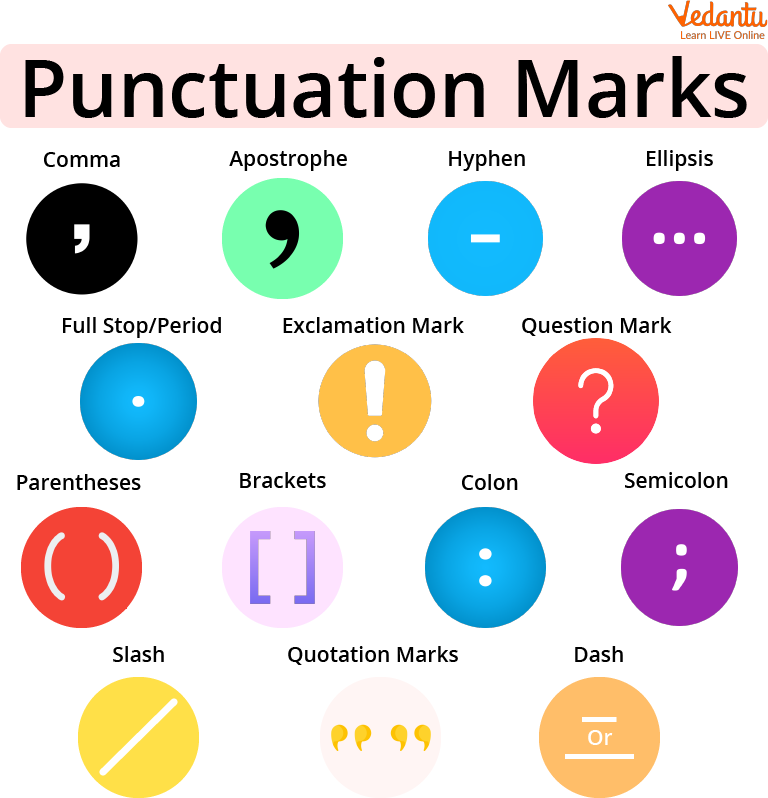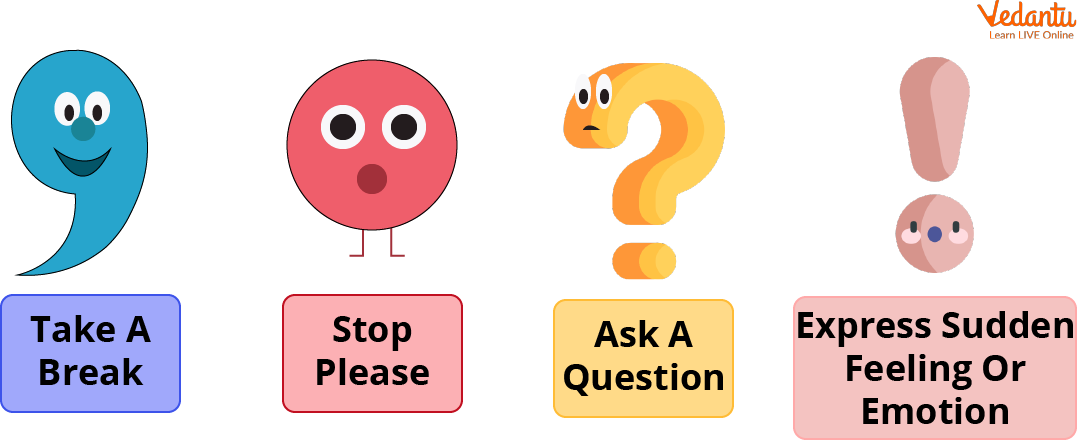




Introduction to Punctuation for Class 2
When speaking to someone, can we tell when they’re happy, sad, angry, or surprised? Yes, we can. But when writing, how do you make the reader understand the emotion one is feeling? How do you help the reader understand the flow of the text?
When speaking, a pause indicates that the next part of the conversation has started. But while writing, how do you let the reader know there is a change in the conversation or that the character will start a new action? To clarify elements like these and make writing easier to understand, we use a grammar tool known as punctuation.
Here, you will learn about Punctuation for Class 2 kids. For a better understanding of the concepts, kids can solve punctuation worksheet for Class 2 children.
What is Punctuation?
Punctuation refers to the usage of symbols, known as punctuation marks to emphasize the meaning of a sentence. It allows the writer to make the sentence easier to understand. Punctuation is also used to highlight the pauses one must give while reading or speaking out the sentence. Essentially, punctuation marks are used, based on their function, to promote the flow of writing and reading.
There are many kinds of punctuation marks, each of which has different functions and alters a sentence differently. These marks can be understood by solving the punctuation exercise for Class 2.

Examples of Commonly Used Punctuation Marks
In the above image, some punctuation marks are shown which can be used in the punctuation sentences for Class 2 kids.
End Sentence Punctuations
These include punctuations that are used to end a sentence. They denote a change from the ongoing sentence to a new one and can often indicate the end of a conversation or thought. The kind of end sentence punctuation used determines the tonality and purpose of the sentence. Given below are some punctuation examples with answers.
Period/Full Stop-
The period or the full stop is represented as “.”. It is used to simply end a sentence and allow the writer to start a new sentence. When reading aloud, a period/ full stop means that the reader must give a significant pause before continuing to read the next sentence.
Example - I am feeling sick, take me to the doctor.
After punctuation - I feel sick. Take me to the doctor.
Question Mark:
A question mark marks a sentence as a question or query. It is represented as “?”. When reading aloud, the presence of a question mark means that the reader has to raise their voice slightly to show that a question is being asked.
Question marks are used in sentences that begin with question words such as when, where, how, what, etc.
Example- Where is the food i left on the table it is kept in the fridge
After punctuation - Where is the food I left on the table? It is kept in the fridge.
Exclamation Marks:
An exclamation mark is used to denote surprise, excitement, or very strong emotion. It can also denote that someone shouted the words or if the sentence needs to be made forceful. It looks like “!” Reading aloud requires the reader to add surprise or excitement to their voice.
Example - I won i am so happy i can't believe i won
After Punctuation - I won! I am so happy. I can’t believe I won!

Types of Punctuation Marks
Other Common Punctuations
Comma:
A comma “,” is used to separate things in a sentence. It can also be used to show a brief pause in the sentence, to separate different parts of a sentence, or after certain words (Yes, No, Sure,) when used at the beginning of the sentence.
For example - can you bring a pen, notebook and the textbook
After punctuation - Can you bring a pen, a notebook, and the textbook?
Apostrophe:
It looks like (‘). It is used to make contractions such as - they’re (they are), can’t (can not), etc. They are also used to show possession.
Example- Isn't this the cat's toy
After Punctuation - Isn’t this the cat’s toy?
Some punctuation examples with answers were explained above.
Summary
Punctuation marks are symbols that emphasize the sentence's meaning and make it easier and clearer to understand. Some punctuation marks such as the period, the exclamation mark, and the question mark are used to end sentences. While these all end sentences, their usage gives a different meaning to the sentence. For better understanding, kids can solve punctuation worksheet for Class 2.
FAQs on Punctuation for Class 2: Basic Rules and Exercises
1. Write one sentence using each of the following punctuation marks.
Full stop
Question mark
Exclamation mark
Comma
1) Raman goes to school every day.
2) What are you writing?
3) Alas! He is dead.
4) Prachi, Suruchi and Neha are best friends.
2. What is the function of different punctuation marks?
Punctuation symbols all have different meanings and usages. A full stop or period is used to indicate the end of one sentence or thought. It allows the writer to begin a new thought or action. The comma separates two items or actions. The question mark is used to indicate that the sentence is interrogative. An apostrophe is used to denote ownership or to contact two words. Proper usage of punctuation marks can be mastered by solving punctuation worksheet and punctuation exercises for Class 2.
3. What are the rules of capitalization after the usage of punctuation marks?
Since some punctuation marks such as the period, the question mark, and the exclamation mark denote the end of one sentence and the beginning of another sentence, the first letter of the first word after the end sentence punctuation is capitalized. Unless the next word is a proper noun, the first letter of the word following other punctuation marks - such as the comma, semi-colon, or apostrophe - is not capitalized.
4. When do we use capital letters in between a sentence?
When a sentence has a proper noun, then we are bound to use capital letters in between the sentence.
5. How do punctuation marks help in speaking?
Punctuation marks help in voice modulation while speaking. Punctuation marks let us know where to take a pause or where to stop. Exclamation marks tell us where to show a sudden emotion of sorrow, happiness, shock, etc. A question mark tells us that we have to ask a question. Proper punctuation is also necessary for speaking as it makes the conversation more engaging and interesting.















